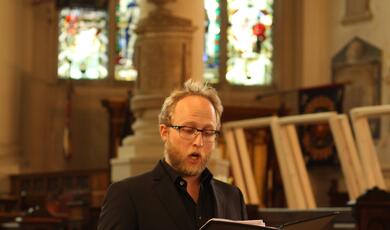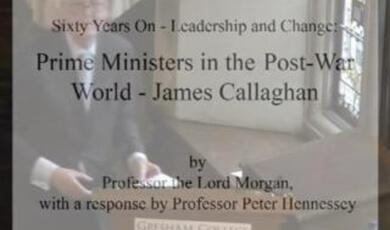Music of Today: Looking Under The Bonnet
Share
- Details
- Transcript
- Audio
- Downloads
- Extra Reading
This illustrated lecture extends a theme of last year's series, that the severity of European modernism is just one strand in modern music, a diversity of which audiences tend to be unaware. This talk strips off the surface labels and seeks less superficial links between apparently contrasted works of art.
Download Transcript
Looking Under the Bonnet
Professor Piers Hellawell
Last year I gave six talks about different aspects of the changing relationship between provider and receiver of art music. In considering this area, the lectures were inevitably retrospective: they were looking over our musical shoulder in order to ask how we arrived at today's state of affairs. This year I shall be more concerned with today: with the diversity of the modern musical age, its chamber music, its teachers, its geographical factors and so on. While most of these topics will involve colloquial speakers who know more than I about specific areas, my first talk is a solo voyage around an issue of concern in modern music. Today I am concerned with stylistic identity - and how to undermine it.
I believe that when our age comes to be scrutinized for its social and cultural thumbprint, this defining feature will be declared to be its obsession with itself. We live in the age that labels, the age that writes lectures about itself, the age that videos itself videoing itself. Everything from digital photography to the radio phone-in is concerned with instant self-documentation, using minidiscs, CD ROMs, cassettes and personal web-pages - and, in abstract terms, the sort of contemporary history that coins terms like 'the swinging 60s' and 'the caring 90's'. The fate of that most superficial and tarnished of apophthegms, 'Cool Britannia', is merely that of all such glib slogans, but speeded up: its nemesis overtook it almost at its launch, a bandwagon overtaken by its own loose wheel. For anything called 'new' or 'cool' is destined to become old and uncool - in that memorable warning, '-isms' become 'wasms'. Maybe that doesn't even matter; these endless labels are snapshots from now, mere notes to oneself in the margin, 'must-have' items today, only to be objects of ridicule tomorrow: as it were, the hot-pants of history.
These polaroid self-portraits have extended far from current affairs into specific art terminologies: new spirituality, magic realism, pop art, neue einfacheit. I think these instant genres have more direct, and more dubious, impact on art than on the rest of life - say, in politics. For in art, the coining of a stereotype is also an invitation, which becomes a pressing invitation, to conform rather than be excluded. Yet fashion invariably answers different agenda to those of durable art: at very least these trendy shorthands are a distraction to the serious practitioner, a gnawing voice that, when someone asks "what's your music like?", whispers "You could say you're one of them!"
He argued as follows: "The problem is, Saatchi's artists don't look much like each other. The Neurotics, says the manifesto, share an interest in strange psychology and the real. This might be said of any collection of contemporary artists picked at random... Nor is Saatchi being as radical as his language suggests. By inventing an -ism with none of the revolutionary, formal power of its modern predecessors, Saatchi is debasing the currency at a time when many are questioning whether all these -isms... actually illuminate works of art, or whether artists just like talking big."
Whereas the opening refrain builds up, the closing one begins as the tutti highpoint, before levelling off into a coda. The trochee motif and the theme are barely disguised in outline.
Jonathan Jones went on to contrast this with the huge upheavals in assumptions that generated the great movements of the past. "The legendary -isms were not just about a new mood or a new generation. They were about the transformation of the world... In art they came to refer to ways of painting that shattered reality as it had been known. This is not a history of art imposed by criticis in love with abstract categories. It's the story modern art tells about itself."
One instructive lesson from all this is that artistic surfaces are utterly unreliable - and this truth carries over into music. My thesis is that today's self-proclamation, and its ugly progeny - simplistic pigeon-holing and themed culture - present the casual student with complacent judgements about musical types that have little to offer. My purpose is to explore how some such works appear once we refuse proffered assumptions about them.
The distinction I want to offer you now is between what music sounds like and what music does - how it behaves. Clearly this is a distinction of time: the sound-surface of any music is a snapshot that we receive in an instant (although our process of sifting is immensely complex), whereas the behaviour of music is something that has to unfold over a period of time - time that the listener may not allow. Music today tends to be judged, like everything else, instantly and on its superficial appearance.
I said 'music today' rather than 'today's music', because the reluctance to consider the unfolding behaviour of music is not restricted to the avant garde: the distinction also affects languages of music that are regarded as in some sort of public ownership. Consider any of the languages of the 18th Century; the popular view that this music is 'melodic' reflects the instant, short-term aspect. It takes only a few moments to be melodic, and the melody aspect is likely to be presented unambiguously, on the musical surface, and at the beginning. Yet the course of any substantial Baroque or Classical piece is likely to involve also 'behavioural' aspects - chiefly, counterpoint and modulation. Counterpoint is when different voices or instruments are combined, playing essentially the same tune (probably that 'melody') but at different times, so that these strands fit together. The more strands are combined, the harder it will be to hear them individually, and it is the sum of those lines that will emerge. This technique, the mainstay of high musical discourse since the 15th Century, was by the 18th Century used to intensify the drama of music, building on more straightforward earlier statements of melodic ideas.
Thus a melody (or 'subject') like this
EX Bach - C major Harpsichord Concerto in C - (iii)
is also a tool for intensification like this later in the movement:
EX ditto Without this developmental aspect, the essential balance between affirmation and its disruption in the classical style is lost, and the listener retains merely a trace of the work. We are, of course, a society that usually requires little more than a trace of the work of art in our quest for entertainment, though we would hardly treat a key sporting event in the same way. But it is not only that we need immediate sensation and have insufficient time for art, though we do: it is that we are poorly attuned to music's narrative-dramatic function, elevating instead its decorative aspect. If only the affirmative, and not the deeper disruptive function of a work by a composer like Haydn is perceived, the listener is effectively leaving a play after the first scene. The senior US composer Elliott Carter, whom I cited frequently in last year's talks, uses the example of classical counterpoint to make a like thrust, that texts help to make sense of such passages for people:
"...it's obvious that most people who are not familiar with music cannot hear counterpoint very well. It's just confusing to them. Now Bach wrote these pieces of staggeringly complicated counterpoint. The opening of the B Minor Mass is one great big thing... it's so dense and there are so many things happening. But I don't think people would grasp that piece if they were not aware that this is the Kyrie Eleison, and not knowing what the text was."(2)
So Carter is saying in that interview that the 'comprehension deficit' in the face of that massive edifice is here being bridged by the text.
Later in the same interview, Carter makes a similar point in praise of Mozart, by way of illuminating his own music - he uses the same phrase as he used above, that there are so many things happening, but this time to praise a rapid turn of events:
"...the thing that interests me in Mozart is ...the extraordinary ability to get through many things rather rapidly, many different things, like the opening of Don Giovanni, for instance, which is one of the remarkable things in music." (2)
EX Mozart: from Don Giovanni (Overture)
Here Carter is talking about the very topic I have raised - what the music does. He praises the pace and variety of events, rather than the identity of this or that specific melodic idea, and this enables him to learn from Mozart's music despite the yawning chasm between the two composers' surface materials.
This is from Carter's 1996 own Sinfonia, and here too, there are so many things happening, however different the surface:
EX Carter: Sinfonia, opening of 'scorrevole' (iii)
If Carter had merely addressed the Mozart at the level of its surface style, rather than in its behaviour, it would obviously have been hard to establish any useful contact. As it is, though, he tells us something not about the sensory surface of the music but about its discourse, which is likely to help us more in the long run.
If we accept Carter's point about the lay person's reception problems with counterpoint, this may also illuminate the specific rift between audience and new music that I addressed in last year's talks. I say this because counterpoint, traditionally a kind of audible crossword puzzle, was one aspect of earlier tradition that did pass through into modernism via the lineage, from Brahms to Schoenberg. As a result, it is music of textural intricacy, of 'action' rather than surface appearance, that is a hallmark of modernists from Webern to Carter himself: there is a corresponding tendency to avoid obvious surface events that offer helpful landmarks to the stranded listener. This does not always make for unlistenable results, but it undoubtedly places the emphasis not on superficial impression but on narrative - often treated to prolonged and concentrated development.
EX Lutoslawski Prelude and Fugues
In that example, the lines are at least separable by the ear. But you may remember I mentioned earlier how when many strands are combined, it becomes harder to hear the parts than their sum; the composer Ligeti took further this idea of subsuming strands into a larger identity, combining so many strands into a 'polyphony' (many voices) that we cannot follow the individual lines; this is also because they play nearly the same materials, but at slightly different times, in the best traditions of counterpoint. He called this sound-mass 'micropolyphony', and it is a good example of how the agenda of music has gone underground, and can no longer be identified often via simple melodic shorthand!
EX Ligeti: Lontano
Clearly the unfolding of this music is a process, something offended by even a longish example such as that. It is easy, but also important, to rail against the impatience and short-termism of fashion, yet that is not my real purpose today. I have been identifying this notion of 'what music does' to explore how this activity may be disguised by the same music's surface identity - just as the contrapuntal depth at the heart of a Mozart movement is belied by its guileless melodic opening.
The modern fad for forensic sorting of everything - even as it happens and according to its most blatant surface aspect - has hit music particularly hard, as I intimated earlier. The cataloguers have long ago moved in to the modern repertoire, with full forensic paraphernalia, in what is perhaps an understandable response to the daunting face of modernist surfaces. To me this uninvited tidying up of art, if understandable, is not only misguided but as infuriating as when a house-guest follows you around saying 'you dropped your newspaper on the sofa'. For I regard the sheer anarchy of the late 20th-century musical scene as positive - the agreeable chaos of a busy family home, rather than the squalor of the degenerate squat. To make the tidiers' job harder, the occupants of this house, like real teenagers, keep taking each others' clothes and leaving them in the wrong room: minimalism, world music and all the other postmodernists just cannot keep their hands off each others' stuff. I like this mess, and think anything is healthier than emerging orthodoxy. When I was a student, a more experienced colleague who knew and swam in 'the scene' as it was in the 70's said something about just such an orthodoxy that still makes me uncomfortable now: his gist was that there was then an established order behind which to fall in: as he put it, 'you can follow ----, or follow ----; there's a kind of status quo, and you just decide'. In my ignorance I was aware of something disquieting here, and now I know what it was: orthodoxy.
So shortly I shall offer a way of looking at music which, while not universally applicable, shows that music can be assessed other than by surface features or universally recognized club membership. For a composer the frustrating aspect of the -ism is two-fold. Not only have the labels accorded to stylistic musical genres overwhelmingly been led, as I implied, by superficial features rather than by the substantive behaviour of the music; equally frustrating is the polarizing effect of -isms on the spectrum of music in this period - for the tendency has been to label that which is most extreme and thus most easily categorized, while the vast amount of music that defies obvious categorization has to live without the help of catchy 'handles'.
Let us consider first the implications of surface-led views of new music. I have already introduced works whose surfaces are merely the tip of deeper processes, and no music of the later 20th Century is more vulnerable to sticky labels than that of the American minimalist movement.
EX Reich - Music for Mallet Instruments
Here the very repetition of surface materials may set the listener off on the wrong tack: the blatancy of the repetition demands the listener's priority, so that it is tempting to link any such work with others which so obviously offer a repetitive surface. But if we approach the music in terms of what it does, rather than what it sounds like, we are reminded that such allegiances can be undermined by behavioural comparison, and, further, that no good music stands still long enough to validate its presumed types. Let us explore such a comparison.
The celebrated work In C by leading West Coast composer Terry Riley makes an instructive comparison with pieces by East Coast master Steve Reich in the same period. Riley's In C, whose performers select at random from a group of a family of motifs that help the music to be 'in C', is like a walk around a field with no path - it has no front or back, but is, in a sense, actually about the moment. Reich, meanwhile, was evolving his 'phasing' technique, the gradual de-synchronization of a pattern being played by unison voices. Thus Reich's Clapping Music is exactly the opposite of Riley's In C - for the clapping 'voices' start and end with the pattern in unison; in between, the second voice delays this pattern progressively by a beat each time, until it is once more in unison with voice one - as if one were to keep putting the last word of a sentence at its front, until the original sequence returned. The very technique says it: this is a gradual unfolding of a process.
EX Reich - Clapping Music (opening to middle)
What I think we should consider therefore is that its behaviour brings Clapping Music closer to some other music without repetitive surface than it is to In C which does have such a surface. Furthermore, there are well-documented departures from this behaviour within Reich's own canon, once he turned away from the strict phasing process of the late 1960's. In short, surface repetition is not everything! Actually it is a mask that covers a variety of specific aspects.
Let me turn to the second cause of frustration, the polarizing effect of niche labels. Most disturbing is that once these niche extremes are established, however illusory their weight, they become couriers of value, and of prevalence. Lazy histories are able to pass down to lazy students such half-truths as 'the story of new music in the 1960s is of the polarity between extreme freedoms and extreme precalculation'; such a view [not a quotation, but certainly a plausible pastiche] is exampled by the sometimes trite results of innovation - some early minimalism, East-influenced improvisation and extreme applications of serialism. Next, the caché of these movements gains momentum and we get the lowest manifestation of 'ism-ism', support that binds to a type of music rather than to music itself, as if all music is a product. Once art becomes a product, its audience becomes a tribe.
Meanwhile - and this is why this polarised picture offends me - practice suggests that most highly individual composers do not join clubs. So nothing can better invalidate such historical shorthand than the fact that most music surviving in today's listening from the 1960s' art music disregards those textbook areas: works by Tippett, Carter, Henze, Britten or Messiaen are awkward for the writers of-ismic potted histories, but glorious for audiences. Attempts to integrate these giants into an ism-driven music history reinforce the idea that such a composer is part of an awkward squad, someone who refused to join a club, a maverick to be accommodated. Thus history becomes the history of genre, of club, of -ism.
The multiplying -isms of our popular music threaten the same fate via hip-hop, garage, drum & bass, Indy and so on. Again the great figures transcend, or at least those long-lived enough to have proved greatness do: 'Merseybeat' seems inadequate for the Beatles, or 'folk rock' for Bob Dylan, for such sustained individuality within a genre is an -ism in itself.
My alternative view of how we may assess modern works - through their behaviour - is not a tidy filing system and is admittedly is a personal view, though that strikes me as preferable to off-the-peg categories. We have already widened the view of Reich's Clapping Music from the ultra narrow aspect of its surface repetition: we have seen that it presents the results of an unfolding process, unlike In C. Let us now widen the lense further, to consider how Clapping Music and its fellow Reich pieces relate to whatever medium gives them a voice. This may sound an arcane question, but music of the 20th Century varies in its relation to the sources of its sounds. There may be a useful parallel in art - I lack the expertise to be sure, but perhaps it is fair to say that canvasses of Pisarro or the 'Fauves' are conditioned heavily by the very paint and bare canvas that creates their illusions and atmospheres - while late Mondrian presents a continuing expression whose artistic materials are its expressive vehicle, rather than what define the ideas.
In music, this amounts to the distinction between a work whose content grows very obviously out of what the instruments can do (the Fauves) and one that brings certain compositional preoccupations to the actual forces, which are then more a means of transmission (Mondrian). We are again defining music's identity here by its overall behaviour rather than its surface detail.
The early works of Steve Reich, minimalist or whatever we call them, serve as an excellent exposition of this. The phasing technique was a direct result of its instrumental context, for Reich discovered that tape delay applied to a brief source recording made possible the multiplication of a single element: one early result was Come Out, a work heavy with the social protest of the civil rights movement, but at a technical level a dazzling exposition of how music can grow out of the properties of its sound-source, in this case the magnetic tape.
EX Reich Come Out (3 excerpts)
Incidentally, it is quite apparent that any style of music can grow out of its instrumental womb: this framework of analysis can illuminate work in any language. It is, after all, a given of non-classical musics too, as when an Irish traditional tune is decorated by ornamentations of an open-hole flute, or when a rock ballad like House Of The Rising Sun opens with arpeggios spaced according to the guitar's strings, on which they were probably put together. Within art music, too, it is usual for composers' imaginations to be reined in by what is possible or comfortable on an instrument - even in the modern age so much associated with pushing at the boundaries of instruments.
Well, in Come Out, Reich was not so much working within the limits of reel-to-reel tape as pursuing an extension of those limits. What was important was that the content is conditioned by its medium (though whether this is the same as defining its 'style' is something we will consider at the end). It allows us to turn to composers from the most distant cultural or musical antecedents and find the same underlying approach to music, at least in specific works, without the need for cumbersome headline labels. Nor is that to say they have no continuing independent concerns in their music - Reich most certainly does - but that such concerns are reinvented in each work according to the properties of its medium.
The Graeco-Romanian composer Xenakis explored in his music the random (or 'stochastic') movement of particles that form clusters - in musical terms, these are dense clouds of pitches forming composite sounds, like Ligeti's micropolyphonies. Yet it is instructive to see how Xenakis interpreted these concerns differently for different media, for example strings and piano: in Tetras for quartet, the possibilities of densities of sound and sliding between two notes, or glissando, mean that individual notes are often subsumed into larger sound-masses. In his piano piece Mists, meanwhile, the preference is for tiny droplets of individual sound; though the piano can articulate sequences of rising pitches in rapid succession, it cannot blur such scales into a glissando, like a string group. Thus the same concerns with composite texture are at work, but their deployment is defined by the medium.
EX Xenakis - Tetras then Mists
Xenakis is a scion of the European modernism invariably seen as the antithesis of the American experimental tradition, yet this tribalism seems irrelevant once we find common antecedents in the music. Nor is the tape piece Come Out a special case for Reich: a comparison of his other 'phasing' pieces, for two pianos and for four violins, shows how the actual materials are in each case conditioned absolutely by instrumental properties, whatever the wider similarities of technique. In Piano Phase the piano's agile repeated flourish, with its distinctive harmony, contrasts with the open string-based Violin Phase, in exactly the same relation as we heard between the string and piano textures of Xenakis. Here are fragments for comparison from Reich.
EX Reich - Piano Phase phase/Four Violins phase
Now just as this approach can establish shared territory between diverse composers like Reich and Xenakis, it can flush out lazy assumptions about similarities of surface. An interesting comparison is this connection is between Xenakis and fellow Eastern European modernist Ligeti. For Ligeti, like Xenakis, has continuing textural concerns growing from the scientific study of matter, represented by sound-masses expressed in choral and instrumental media: the squirming instrumental polyphonies of Ligeti appear very close to the swarms of glissandi we heard earlier in Xenakis. Yet I believe a very fine but important boundary separates them, for Ligeti, to my ears, is on a different path to that of Xenakis or Reich in imposing his material concerns to a large extent on various instrumentations, where they discover interpretations of them within his forces. Examples of Ligeti from the 1960's will illustrate this - from a wind quintet Zehn Stücke, the Kammerkonzert (a mixed work for wind strings and keyboards) and the String Quartet no 2:
EX Ligeti - Zehn Stücke/Kammerkonzert/String Quartet no 2
The musical specifics of these examples - small intervals and layered rhythmic complexes - are extremely similar, but the point is that they appear to be independent of their instrumental vehicles (which is not to denigrate the expert and idiomatic scoring). Ligeti appears to use the various media as vehicles for his characteristic materials, where a composer of the other type works to a marked degree with something the medium allows or suggests - like tape delays or string glissandi. It is absolutely impossible to be dogmatic about such definitions - one of my objections to -isms is their false certainties - and what holds good for a composer in some works may not apply to exceptional others. This is not a fault of my approach but rather its defining feature: it is designed not to categorize composers but to illuminate their works, so that a deviation within a composer's work is not an embarrassment but a discovery. For example Ligeti clearly belongs to the other type in his early organ works, such as Volumina, in which he extracts remarkable sound expression from the mechanical properties of the organ.
EX Ligeti - Volumina
The composer who best embodies the 'discovering' approach we have seen in music by Reich and Xenakis is the best-known name in European modernism, Karlheinz Stockhausen. His work has travelled stylistically more than that of any contemporaries, yet he demonstrates consistency at this less superficial level. For Stockhausen shows a tendency to generate from within media that exceeds anything we have seen, in the range of expression it produces over his mature output. The early Zwei Studien for electronic tape are thus, like Reich's Come Out, the product of experiments in the studio, here using sine waves; correspondingly, nearly 20 years later, Stockhausen is generating -'discovering' - his 75-minute work Stimmung ('tuning') from the human voice. Of course these works, along with others in between them like Zyklus for percussion and Gesang der Junglinge for tape - are linked by a living preoccupation with raw sound material. But what makes each individual within that genre is how its specific materials interpret that concern from deep within the medium. Stimmung is a meditative exploration of a single harmonic series, on the note Bb, which in practice means a single chord of the 9th. This is animated by chanting, magic names and the like, but most of all by vocal harmonics, that give a 'jew's harp' twang when isolated by expert singers. In this way the piece is inextricably vocal; it could not exist in any similar form independently of the voice.
EX Stockhausen - Stimmung (long excerpt)
I have already shown how this view of new works can liberate composers from the chains of contrasting tribal identities. The same works just as well for composers in my other model - composers who project their preoccupations upon different instrumental media. For Ligeti's consistent pursuit of abstract materials can be aligned with that of Arvo Pärt, a composer whose work has probably invited more labels and stigmata than that of any living colleague, and one popularly seen as a breakwater against the modernism of Ligeti or of Carter.
Though we associate Pärt's mature style overwhelmingly with sacred vocal music, yet its main attributes were developed long ago in music for other media: in the 60's and 70's, key aspects occur in, for example, orchestral media, before persisting into the later works with remarkable concentration. In fact it is striking, given the perception of Pärt as a 'choral' composer, that his enduring traits are imposed on, rather than generated by, the voice. Furthermore, this continuity in Pärt's work cuts across marked stylistic changes that, as usual, make headlines while disguising the deeper unities.
Pärt's underlying technical processes may be at a dry and detailed level but they, like those of Ligeti, reveal fundamental intentions about the unfolding of music. Here too, strands of polyphony multiply into texture, though the individual lines are often starkly plain. But another kind of multiplication is at work in many of Pärt's scores, gradually expanding these individual lines. For example, the composer tends to construct a single line by addition of a new note alternately to the front, then the end, and so on. This occurs in the Credo of 1968, a work whose actual style is heavily conditioned by polystylism, for it is actually based upon Bach's C major keyboard Prelude. Post-modern experimental commentary of this kind, subjecting a well-known musical text to collage, is as far as can be imagined from the 'purity' of Pärt's later, 'tintinnabuli' language that you will hear in a minute. Yet there we find exactly the same additive generation of lines, still being expanded in unobtrusive chain links in a technique that cuts across the individual media. In his central masterpiece Tabula Rasa, this expansion is a ripple-effect that carries the music outward further each time from a recurring arpeggio on distorted piano:
EX Pärt Tabula Rasa (ii)
Thus, whatever the composer's stylistic journey, the unifying factor is again the imposition of underlying behaviours on different media.
There remains the question of how much the stylistic evolution of such composers is related to these twin tendencies - whether in the discovery of materials (as in Reich), or in their imposition (as in Ligeti). Is this the same as a composer's 'stylistic development'? For all great composers present a balance between continuity and contrast, in some context. My feeling is this: the composer firstly whose discovers materials from within a musical medium in doing so inevitably conditions his stylistic development.
The phasing that Reich pioneered in his early works is his surface style, in that the sound of the music rests upon that actual process.
The meditative impact of music by Stockhausen in the early 1970's is, likewise, defined by its static materials. When Reich moves on to doing something slightly different, the sound changes and we are in a new terrain. In other words, we can say that the discovery of materials of works and the style of such works are inseparable. Furthermore, such stylistic changes may actually take the composer into the other type I have been examining: for in Reich's later development he was to unfold a set of chords as foundation for an entire work, Music For 18 Musicians. It is hard to imagine a more abstract material, one imposed more thoroughly from outside, than a chord sequence. Reich, like Ligeti, can be a different kind of animal in this respect at different periods.
Turning to the other type I have examined, the composer who imposes characteristic concerns on various musical media is less likely to be thus conditioning stylistic periods. This difference is not surprising. The composers who 'discover' within media are uncovering materials - string or vocal harmonics, the effect of mechanical organ bellows - while the 'imposers' are usually imposing techniques - rhythmic procedures, ways of extending a line and so on. It is music's raw materials that characterize surface 'style' in particular, so it is the burrowers into their media whose findings so condition what they write at that time; the abstract techniques I have introduced from other composers of today are by nature more widely transferable, and thus independent of surface.
The point of all this is that it makes us ask detailed and fundamental questions about the music. The hateful thing about the musical bumper - stickers I rejected earlier is that they do the opposite: by conforming to established expectations, they create assumptions about what a piece, or an entire output of a composer, will do before we hear it. A most frequent error among academic music students is to confuse style and technique, describing serial composition as 'the 12-note style' or any piece using repeated materials as 'minimalist'. I think there is no more important distinction in approaching today's music than that between what - on brief inspection - an individual piece sounds like and how - on closer inspection - that piece behaves.
This event was on Sat, 05 Oct 2002
Support Gresham
Gresham College has offered an outstanding education to the public free of charge for over 400 years. Today, Gresham plays an important role in fostering a love of learning and a greater understanding of ourselves and the world around us. Your donation will help to widen our reach and to broaden our audience, allowing more people to benefit from a high-quality education from some of the brightest minds.


 Login
Login






